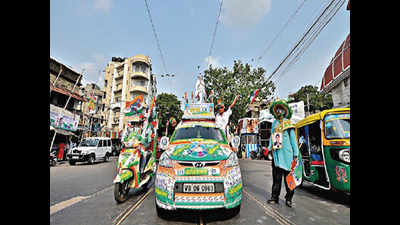- News
- City News
- kolkata News
- Trinamool retains Kolkata bastions, but BJP registers rise in vote share
Trending
This story is from May 24, 2019
Trinamool retains Kolkata bastions, but BJP registers rise in vote share
The city and its surroundings went against the tide and kept the Trinamool afloat in all the five constituencies — Kolkata Uttar, Kolkata Dakshin, Jadavpur, Dum Dum and Barasat (that includes Salt Lake) — which turned out to be a ray of hope for the party in the civic polls in 2020.

Trinamool’s show may give it an edge in the city civic polls next year, but BJP has also gained ground with Left ending at third position in all the five key seats in Kolkata and its surroundings
The city and its surroundings went against the tide and kept the Trinamool afloat in all the five constituencies — Kolkata Uttar, Kolkata Dakshin, Jadavpur, Dum Dum and Barasat (that includes Salt Lake) — which turned out to be a ray of hope for the party in the civic polls in 2020. Trinamool candidates in these five seats were leading from the very start and kept increasing their leads.
Trinamool could protect its city fort from the saffron wave in other parts of Bengal, though there has been a significant surge in the BJP’s vote share in these seats at the cost of mainly Left and Congress.All these five seats, like elsewhere, witnessed a polarisation that has pushed the Left to the third position. Even in Jadavpur, where Left supporters were banking on Bikash Bhattacharya. Trinamool candidate Mimi Chakraborty was leading from this constituency by over 2 lakh votes till 5pm. BJP, despite having a relatively weak candidate like Anupam Hazra, polled 28.5% votes, up by 16% from its 12.2% vote share in 2014 Lok Sabha polls.
CPM’s vote share here slumped from 36% to 21% registering a drop by 15% which explains the polarisation. But unlike in the districts the public anger over not being able to cast votes in the 2018 Bengal rural polls didn’t sharpen the degree of polarisation evident in rural areas.
Trinamool increased its vote share in Kolkata Uttar, Kolkata Dakshin, Barasat and marginally in Jadavpur and Dum Dum. This could be because the party has an advantage in four Lok Sabha seats — Kolkata Uttar, Kolkata Dakshin, Jadavpur and Barasat — that have an above 20% Muslim population. However, the increase in Trinamool vote share indicates that a section of the city people considered factors other than the much talked about religious polarisation. The smashing of Vidyasagar’s bust during BJP president Amit Shah’s roadshow in central and north Kolkata might have worked against BJP in Kolkata North. This apart, the urban poor, the slum dwellers, petty traders and a section of the middle class averse to BJP voted for Mamata Banerjee’s party.
The Modi-Mamata binary has dealt a blow on Left and Congress whose vote shares have shrunk, further sending out clear signals of the tectonic shift in the state’s political matrix.
Trinamool could protect its city fort from the saffron wave in other parts of Bengal, though there has been a significant surge in the BJP’s vote share in these seats at the cost of mainly Left and Congress.All these five seats, like elsewhere, witnessed a polarisation that has pushed the Left to the third position. Even in Jadavpur, where Left supporters were banking on Bikash Bhattacharya. Trinamool candidate Mimi Chakraborty was leading from this constituency by over 2 lakh votes till 5pm. BJP, despite having a relatively weak candidate like Anupam Hazra, polled 28.5% votes, up by 16% from its 12.2% vote share in 2014 Lok Sabha polls.
CPM’s vote share here slumped from 36% to 21% registering a drop by 15% which explains the polarisation. But unlike in the districts the public anger over not being able to cast votes in the 2018 Bengal rural polls didn’t sharpen the degree of polarisation evident in rural areas.
Trinamool increased its vote share in Kolkata Uttar, Kolkata Dakshin, Barasat and marginally in Jadavpur and Dum Dum. This could be because the party has an advantage in four Lok Sabha seats — Kolkata Uttar, Kolkata Dakshin, Jadavpur and Barasat — that have an above 20% Muslim population. However, the increase in Trinamool vote share indicates that a section of the city people considered factors other than the much talked about religious polarisation. The smashing of Vidyasagar’s bust during BJP president Amit Shah’s roadshow in central and north Kolkata might have worked against BJP in Kolkata North. This apart, the urban poor, the slum dwellers, petty traders and a section of the middle class averse to BJP voted for Mamata Banerjee’s party.
Signs of anti-incumbency or pro-Modi sentiments were on the rise in all these seats in the 2014 Lok Sabha polls. Kolkata Dakshin and Kolkata Uttar were few among the 42 Lok Sabha seats where BJP polled 25% votes in 2014. The BJP’s vote share has gone up to 34.3% in Kolkata Dakshin and 36.5% in Kolkata Uttar showing how polarisation fever is catching on the minds of large sections of educated middle class. The party has also improved its vote share in Dum Dum, particularly in Khardah, North Dum Dum and Kamarhati that have a sizeable refugee population.
The Modi-Mamata binary has dealt a blow on Left and Congress whose vote shares have shrunk, further sending out clear signals of the tectonic shift in the state’s political matrix.
End of Article
FOLLOW US ON SOCIAL MEDIA










